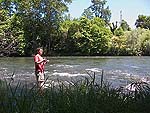Landra and I recently stumbled on a very unique travel destination. It required us to leave the [an error occurred while processing this directive] behind for a few days, but it provided an experience that most people are not even aware exists. As we found out, there are indeed fully furnished tree houses in which you can spend the night.
The scenic drive from Medford to Takilma took about an hour, half of that spent on narrow country roads. Southern Oregon is full of mountains and streams, and this drive gave us plenty of both.
The Lilly Pad is located on a wooded lot in the small town of Takilma, Oregon, near the California border. It is owned and tended by Sandy, a long-time Oregon resident. A unique feature of this Bed & Breakfast is that currently there is a single room in the tree—no other guests to disturb the serene landscape.
Directions to the tree house were very adequate and necessary. The toughest part was noticing the sign at the narrow driveway entrance. We drove toward the back of the lot and parked near the tree house, which was built on the trunk of an aromatic cedar, estimated to be 150 years old. From this location no road or neighbor houses were visible.
Sandy gave us a warm welcome and told us a little about the tree house and the tree on which it was built on. It was about twenty feet off the ground. No climbing was necessary because a small suspension bridge from the hillside took us directly to the door.

Entrance to the tree house is via a suspension bridge from the hillside.
The structure was firmly held to the tree with steel cables attached to Garnier Limbs, named after the inventor Michael Garnier. These “limbs” are short steel rods inserted into the tree trunk at various locations. The rods went as far as the heartwood and were protruding from the trunk just enough to attach the cables.
As we walked over the bridge and opened the door, the first thing we saw was the large tree trunk filling the middle of the room. The furniture, appliances, and fixtures were arranged around the perimeter of the hexagonal room. This year was the Lilly Pad’s second season. As expected, everything looked new inside and out.

Looking through the door, tree trunk occupies the center of the hexagonal tree house.
After our experience in the Lilly Pad, I have done more research on tree houses. Other unique features of the Lilly Pad generally not available in trees are: cold and hot running water, and a flushing toilet. A very cozy and rustic shower was on the ground, with plenty of hot water to offset the cool morning air.
It was still cool in the evenings and large plastic sheets were covering the windows to keep in the warmth of the small propane heater. Layers upon layers of cozy comforters and blankets kept us warm in the queen-size bed. The tree house also had two bunk beds which would have been a lot of fun for kids. Our only child, Sam (the miniature Schnauzer), took the bottom bunk.
At night the wind was calm and rarely any sound could be heard over the low rush of the near-by Illinois river. An occasional barking dog could be heard, but the night was mostly silent; a nice change from the noisy diesels in the RV p

Charlie Kerekes
Original founder and writer for Changin' Gears. Former full-time RVer!











